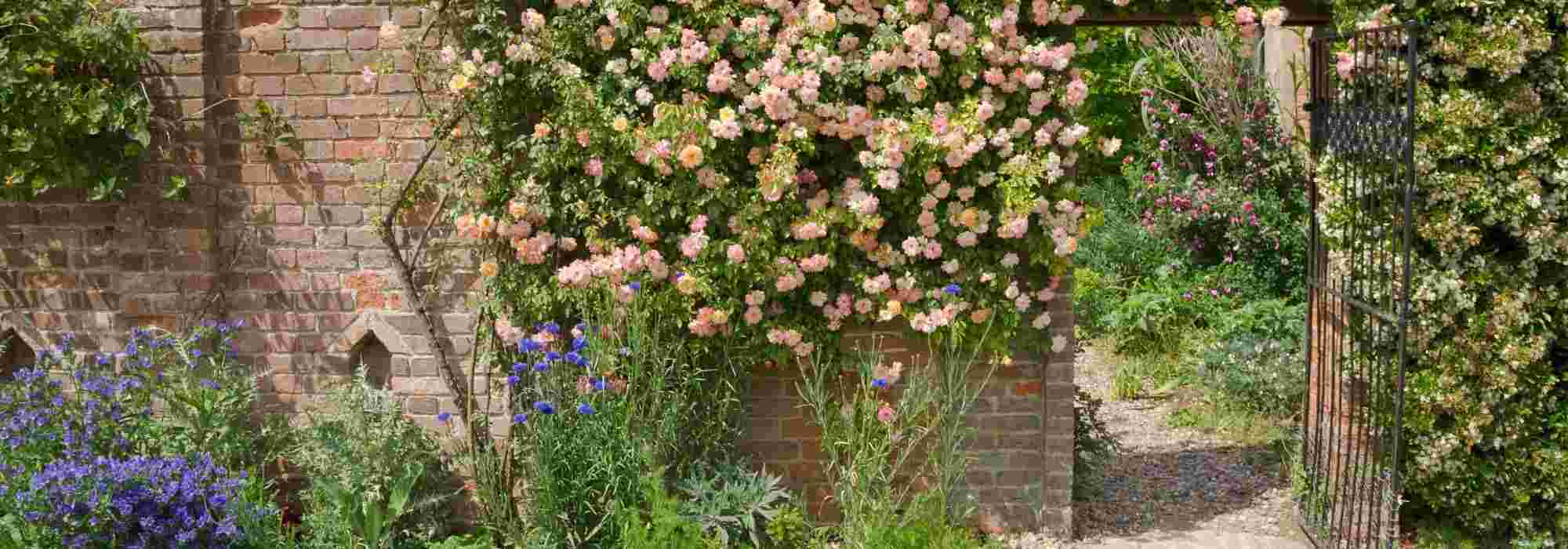
What to plant at the foot of a wall?
Our tips to adorn a wall or facade
Contents
The green covering of a wall has multiple advantages. Whether it is to hide an unsightly façade, provide thermal insulation, or make a neglected space warmer and more welcoming, it is important to consider the orientation of your wall before embarking on your project. Indeed, the selection of plants and materials must be rigorous to cover a wall with climbing plants. To dress the front of your house with a flowerbed, it is preferable to choose perennials and evergreens with successive flowerings to enjoy this decoration all year round.
Here are our ideas, tips, and mistakes to avoid to enhance a wall in the garden.
What to plant along a North-facing wall?
For many amateur gardeners, dressing a wall exposed to the North may seem complicated. Indeed, this dark and damp location is often left neglected, as it gives the impression that the area is not suitable for planting a green decor. It’s time to prove otherwise. It simply requires choosing the right plants, specifically plants that are very tolerant of permanent shade, moisture, cold, and frost in winter. Opt for woodland plants, flowers that will add colour, decorative foliage to bring brightness, and hardy perennial plants that will have a life cycle over several years. Here is our suggestion of plants to install in front of a North-facing wall:
- Flowering plants: Bleeding Heart, Columbine, bulbs of Naples Cyclamen to be placed in the foreground, Hellebore, Hydrangea macrophylla or arborescens, the hardy Fuchsia magellanica var. gracilis, and the hardy and decorative Dogwood
- Decorative foliage plants: Hosta, Heuchera, and ferns
- Ground cover: Lamiastrum galeobdolon ‘Hermann’s Pride’ with variegated foliage and yellow flowers, Lesser Periwinkle, and Epimedium
- Heather soil shrubs: Azalea, Rhododendron, and Camellia japonica ‘Kerguelen’.
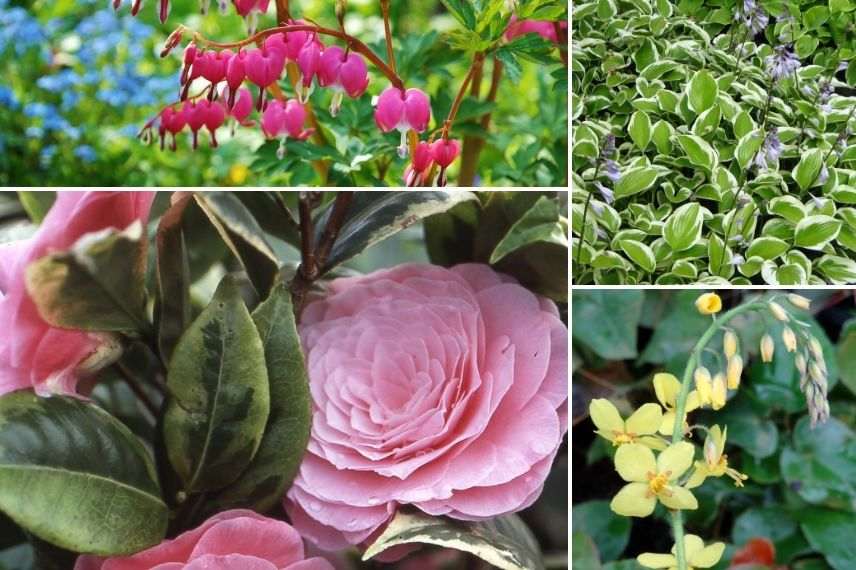
Dicentra spectabilis (photo Pixabay), Hosta ‘Queen Joséphine’, Camellia japonica ‘Kerguelen’, and Epimedium perralchicum ‘Frohnleiten’
What to plant along a south-facing wall?
A wall exposed to full sun will absorb heat all day and release it throughout the night. This is the hottest and driest exposure. To counter this, choose plants that are highly tolerant to heat and sun, such as cacti or succulents, which thrive in such dryness. For other plants that are slightly less resilient, you can assist them by mulching around their base. Indeed, mulching prevents excessive water evaporation and helps keep the base of the plants cool. Oyas are another simple and effective solution for delivering moisture directly underground. Here is a selection of plants suitable for a south-facing exposure:
- Cacti and succulents: the hardy Agave havardiana and montana, the Opuntia atrispina with changing flower colours, Delosperma, Houseleek, and Sedum
- Flowering plants: Garden Valerian, Aubrieta, Erigeron karvinskianus, Hollyhock, and perennial Helichrysum
- Bushes: Lavender, the tender Cistus, Ceratostigma willmottianum ‘Forest Blue’, Perovskia, and Ceanothus
- Grasses: Blue Fescue, Pennisetum orientale ‘Shogun’, and Stipa tenuifolia
- Fruit trees: espaliered pear, cordon apple, vine, kiwi, and citrus trees in the mildest regions.
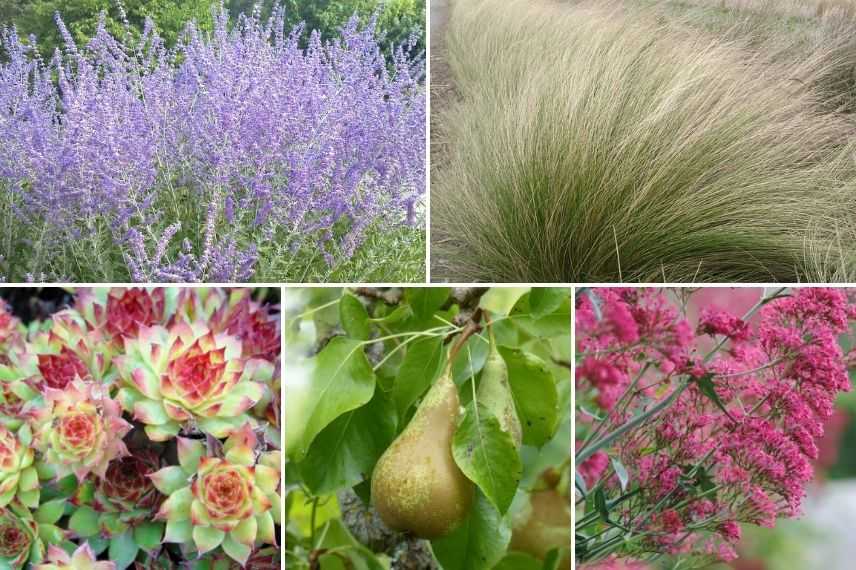
Perovskia atriplicifolia ‘Blue Spire’, Stipa tenuifolia, Sempervivum tectorum ‘Noir’, Pear ‘Conference’ (photo snapp3r) and Centranthus ruber
What to plant along an East-facing wall?
An east-facing wall benefits from morning sun only, which is advantageous for plants that cannot tolerate the scorching afternoon sun. However, one must be cautious of the rapid thaw that occurs on winter mornings, which can damage plants due to a sudden change in temperature. At the base of this wall, one could plant: Bergenia, Brunnera, Hemerocallis, hardy geraniums, Japanese quince, viburnum, rhododendron, Philadelphus x lemoinei, Japanese spiraea, and Physocarpus.
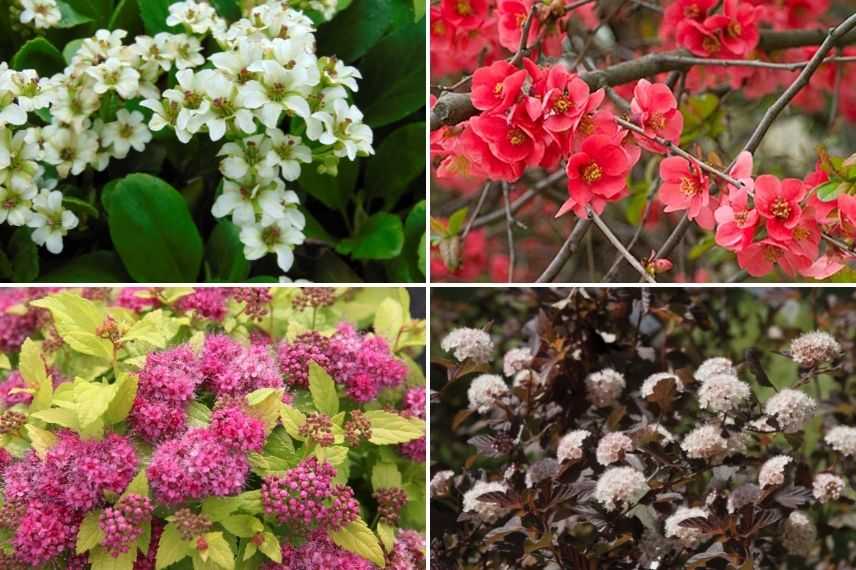
Bergenia ‘Bressingham White’, Chaenomeles superba ‘Nicoline’, Spiraea japonica ‘Double Play Gold’ (photo Denolf) and Physocarpus opulifolius ‘Diable d’Or’
Read also
How to train and stake clematis?What to plant along a West-facing wall?
In front of a wall to the West, shade predominates in the morning and the sun in the afternoon. In this situation, care must be taken with the wind, which is more prevalent than in the East. Some plants will need to be staked to prevent them from breaking. Here are some plants suitable for exposure along a West-facing wall: Roses, Peonies, Daylilies, Ethiopian Arum, Mexican Orange, Pittosporum, and Lagerstroemia indica ‘Berlingot Menthe’.
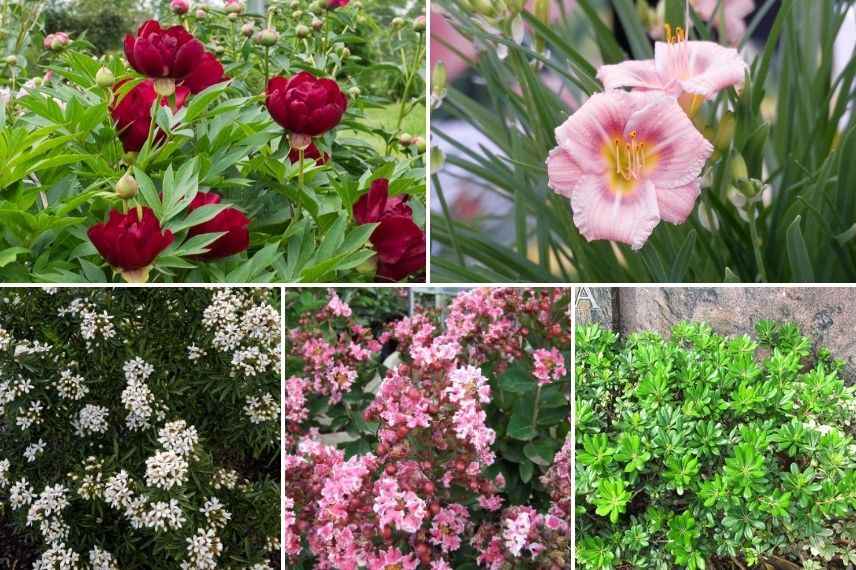
Paeonia Itoh ‘Scarlet Heaven’ (photo FD Richards), Hemerocallis ‘Everydaylily Rose’, Choisya ternata ‘Snow Flurries’, Lagerstroemia indica ‘Berlingot Menthe’ and Pittosporum tobira
How to cover a large wall?
Unsightly walls can be camouflaged with climbing plants. Opt for evergreen foliage, as it provides coverage all year round. Often, climbing plants require little ground space to thrive, which is an advantage for small areas. Additionally, it is possible to combine two climbing plants in the same location. Here are our favourite climbing plants to green up a wall:
- Against a north-facing wall: Schizophragma, Ivy, the evergreen Hydrangea seemanii or petiolaris, which is deciduous, and Pileostegia viburnoides
- Against a south-facing wall: Wisteria, Passionflower, Trumpet vine, Bougainvillea in the mildest regions, and Common Jasmine, which is less susceptible to diseases
- Against an east-facing wall: Honeysuckle, Schisandra, Akebia, and Hops
- Against a west-facing wall: a Cobaea, Climbing Roses, Star Jasmine, Virginia Creeper, and Clematis.
Tip: if your wall is very light, avoid planting climbing plants with delicate foliage, such as Akebia. Indeed, the leaves can be scorched by the heat reflected from a white wall facing south.
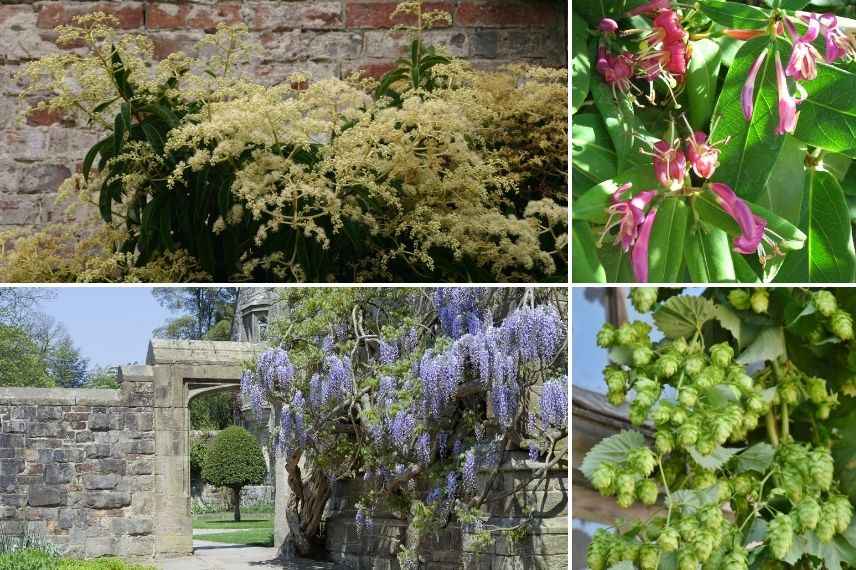
Pileostegia viburnoides (photo L. Enking), Lonicera henryi, Wisteria floribunda (photo yolfran), and Humulus lupulus ‘Magnum’
What support systems should be used for climbing plants?
If Ivy, Virginia creeper, Trumpet vine, and Climbing hydrangea manage to climb walls on their own thanks to their climbing roots, other climbing plants need a support to attach to and grow upwards. There are many systems for dressing a façade:
- trellises, mesh, and taut cords: more suitable for climbing plants with voluble stems, such as Honeysuckle, Hops, and Clematis
- metal cables that can be tensioned and fixed to the wall using hooks; they are often sold in kits and are more discreet than trellises: ideal for training roses or fruit trees
- sturdy stakes made of metal or large-diameter wood: suitable for Wisteria, which will become lignified over time, so the support must not crack.
It is also possible to create your own support.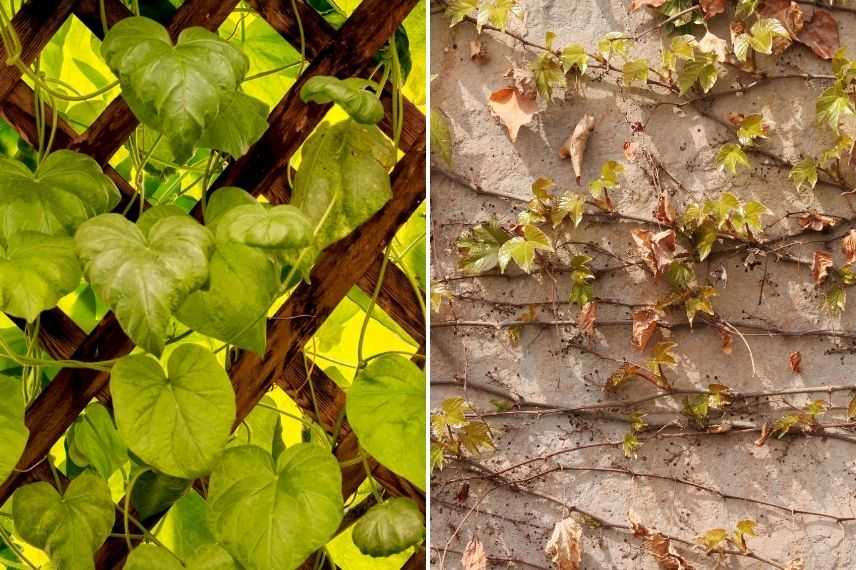 On the left: climbing plant growing on a trellis; on the right: Virginia creeper attaching itself to the wall
On the left: climbing plant growing on a trellis; on the right: Virginia creeper attaching itself to the wall
Which plants should not be placed against a wall?
Do not plant a tree too close to a wall, as the roots may damage the foundations.
Bamboos have running roots that multiply very quickly and they can become invasive if no rhizome barrier has been installed during planting. Not only does this represent an additional cost, but there is also the risk of ending up with a monochrome, sad, and imposing green wall. Furthermore, bamboos shed a lot of leaves that need to be raked, and you must regularly ensure that no rhizome crosses over the barrier, as this can happen.
If your render is new, avoid planting ivy, Virginia creeper, trumpet vine, and hydrangea, as their climbing roots and suckers can damage the walls.
Caution: regarding climbing plants, be aware that gutters can become blocked if the plant reaches their level. Regularly check and prune your green wall if necessary. Also, be vigilant with ivy, as if it infiltrates under the tiles of your house, it could harm the impermeability of the roof.
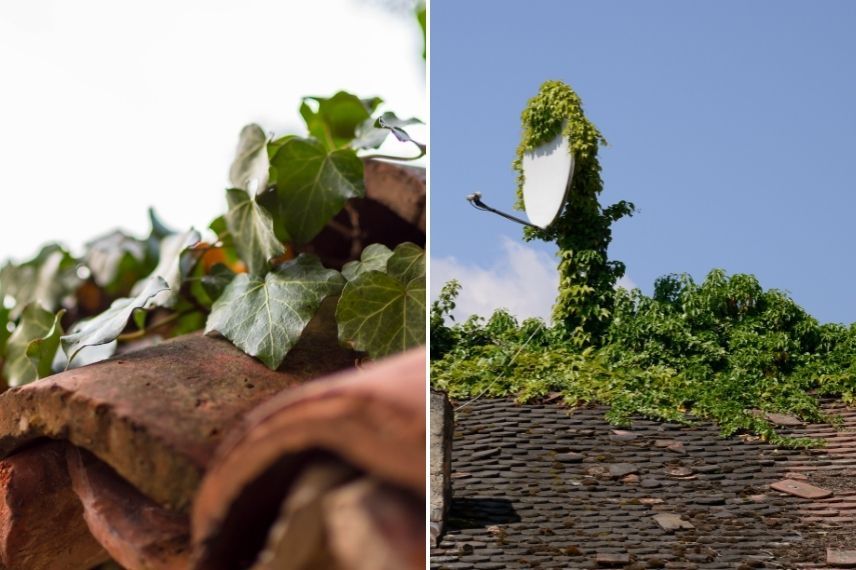
Ivy invading roofs
- Subscribe!
- Contents
































Comments